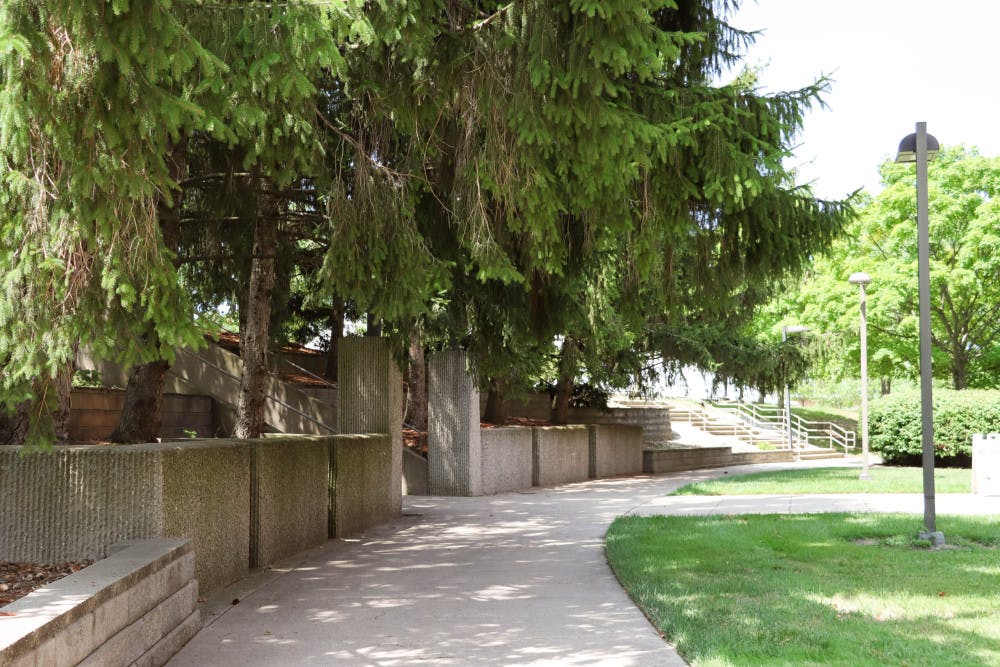Dayton Street Tree Planting info | Photo by Bethany Althauser | The Wright State Guardian
The city of Dayton and Montgomery County’s streets may appear fuller this fall, as two programs plan to provide free trees to qualified areas. Both initiatives aim to improve water pollution, flooding, rising energy bills and health factors, including mental health and risk of respiratory illness.
Dayton Street Tree Planting & TERP
The city of Dayton and the Montgomery County Land Bank have both funded an initiative providing free trees in eligible urban areas and neighborhoods, starting this fall.
Dayton is ensuring residents are able to take advantage of the opportunity through offering free tree planting in the public right-of-way, such as curbs and sidewalks.
To those interested, residents may complete a simple request form on the city of Dayton’s website, inquiring basic information, along with room to leave comments and specific requests. Once submitted, requests will be analyzed and, if approved, tree planting can be expected to begin mid Oct.
The initiative was funded by the city, and expects to yield benefits to the area and residents.

Dayton citizens are not the only ones to be offered free tree planting in the area.
The local land bank is offering Montgomery County a separate and unique initiative through the Tree Equity Reforestation Program (TERP). The program will offer free trees to eligible private properties.
“The Tree Equity Reforestation Program (TERP) provides trees to Montgomery County homeowners in areas that have been historically and economically disinvested,” Crystal Thomas, the land bank’s Program Assistant, said.
TERP’s request form provides more options for types of trees and specificities that may appeal to residents looking to beautify neighborhoods, among other urban areas.
Qualifications and what to expect
Both initiatives remain inclusive to all interested in having a free tree planted in one’s area. No specific requirements are needed besides location of where a tree is desired.
Dayton’s tree planting program focuses on planting trees only in public right-of-way, while the land bank is tackling private properties such as neighborhoods.
“Planting space must be minimum of 3 feet wide, 10 feet away from underground and overhead utilities, 25 feet from stop signs, and 25 feet from intersections”, Bryan Urban, head of Dayton’s Forestry Department, said.
If a resident’s area meets these requirements, then the location will be surveyed by the City Forester, who will make the final determination.
Urban ensured that no specific areas of the city are being targeted for more or less trees.
The land bank’s program is less specific with location requirements, focusing on planting trees in eligible Montgomery County neighborhoods.
Residents can expect to see 200 to 300 free trees planted this fall. TERP expects to plant a large number of trees for the community as well, as the land bank has been offering this program for a few years now.
Mission and potential benefits
Both programs share a common goal of expanding the urban tree canopy in Dayton and the surrounding area, which they expect to bring benefits to citizens.
“Our goal is to increase tree canopy coverage city-wide. Trees have numerous benefits including keeping homes cooler, combating urban heat island effect and helping to increase property value,” Urban said.
The expansion of Dayton’s tree canopy will bring about other advantages which align with the land bank’s TERP mission.
“The focus of the program is to provide trees in urban areas so that everyone can experience the health, climate, and economic benefits,” according to the land bank’s website.
In addition to benefits listed by Urban, residents may notice a reduction in water pollution, flooding and energy bills. The initiative aids in the improvement of health factors including mental health and risk of respiratory illness.
Past planting
2024 is not the first year citizens have received free tree planting from the city. This initiative has been carried out many years, dating back to 2017.
According to Urban, the feedback has remained positive from citizens and each year has continued to aid in the urban tree canopy expansion.
Dayton’s number of trees planted each year varies, with the lowest amount being 35 planted in 2022, and a record number of 430 in 2017.
Through TERP, 132 trees have been planted in eligible Montgomery County neighborhoods in the past few years.
Each program has allowed residents in the Dayton and Montgomery County area to participate in beautifying the community and reaping the benefits that follow with sustainability and maximization of the urban tree canopy.












